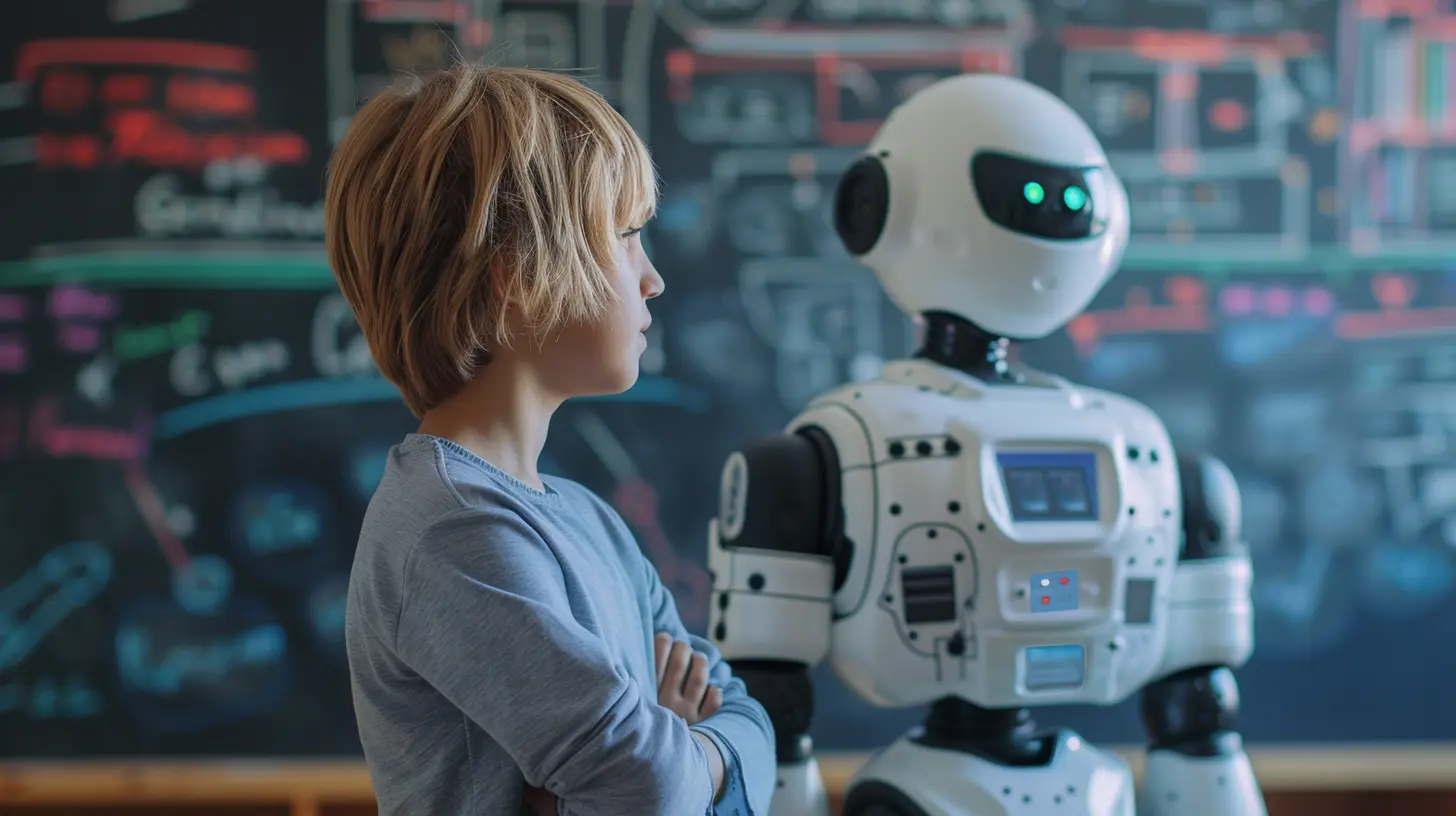Empowering Educators with AI-Driven Feedback
6 January 2025
The classroom is changing, and it's happening faster than we ever imagined. Gone are the days when chalkboards and textbooks defined the learning experience. Today, technology is taking center stage, and among the most exciting advancements is the rise of Artificial Intelligence (AI) in education. Specifically, AI-driven feedback is revolutionizing how teachers interact with students, assess their performance, and personalize learning experiences.
In this article, we’re diving deep into how AI-driven feedback is empowering educators and transforming the classroom. Whether you're a teacher, administrator, or just someone curious about where education is heading, this guide will give you all the insights you need.

What Exactly Is AI-Driven Feedback?
Let’s start with the basics. AI-driven feedback refers to using artificial intelligence to provide real-time, personalized feedback to students as they learn. Rather than relying solely on traditional grading systems or manual comments from teachers, AI analyzes student performance and offers suggestions for improvement, tailored to each individual.For instance, imagine a student working on a math problem. Instead of waiting for the teacher to grade their paper, an AI system could immediately point out mistakes, offer hints, and guide the student toward a correct solution. All this happens in real-time, enabling students to learn from their mistakes without delay.
But AI-driven feedback isn't limited to math. It’s being used across subjects, from essay writing to science experiments, helping educators provide more accurate, timely, and personalized responses.

How AI-Driven Feedback Is Changing the Role of Teachers
You might be asking, “Does this mean AI is going to replace teachers?” Absolutely not. AI is here to assist, not replace. The role of teachers is evolving, and AI is making their lives easier by automating repetitive tasks, freeing up more time for what really matters—teaching and mentoring.1. Efficiency and Time-Saving
Let’s face it, grading can be a time-consuming task. Teachers spend hours evaluating papers, marking quizzes, and providing feedback. AI-driven systems take over this repetitive work, freeing up educators to focus more on personalized instruction and student engagement. Instead of being bogged down by administrative tasks, teachers can spend more time fostering creativity, critical thinking, and problem-solving skills in their students.2. Personalization at Scale
One of the greatest challenges in education is meeting the diverse needs of students. Every student learns at their own pace, and it’s nearly impossible for teachers to provide individual attention to every student in a crowded classroom. Here’s where AI shines. AI-driven feedback tools analyze student data, track progress, and customize responses based on each learner’s strengths and weaknesses.Imagine having 30 students in a classroom, each learning at a different speed. AI can provide individual feedback to every student simultaneously, ensuring no one is left behind. It’s like having a personal tutor for every learner, but without the one-on-one time commitment from the teacher.
3. Reducing Cognitive Load
Teachers are often overwhelmed by the sheer amount of information they need to process—lesson plans, grading, student queries, parent meetings, and more. AI-driven feedback systems help alleviate this cognitive load by automating many of these processes. This allows educators to focus on higher-order tasks, such as developing creative lesson plans or engaging students in deeper discussions.
The Benefits for Students
While AI is a game-changer for teachers, it’s also revolutionizing the student experience. Let’s take a closer look at how AI-driven feedback benefits students.1. Immediate Feedback
We’ve all been there—turning in an assignment and waiting days or even weeks to find out how we did. This delay can cause students to forget what they were learning, making the feedback less effective. With AI-driven systems, feedback is immediate. Students can correct their mistakes right away, keeping them engaged and motivated to improve.2. Personalized Learning
Every student is different. Some struggle with math, while others excel at it but need help with writing. AI-driven feedback adapts to each student's needs, offering tailored suggestions and guidance. This personalized approach helps students take ownership of their learning, making them more likely to succeed.3. Confidence Building
For many students, receiving feedback can be intimidating, especially if it’s negative. AI-driven feedback systems are designed to be supportive and constructive. Instead of simply pointing out what’s wrong, they offer solutions and encouragement, which helps students build confidence in their abilities.4. Increased Engagement
Let’s be honest, sometimes traditional feedback can feel boring or repetitive. AI introduces a dynamic element to learning by making feedback more interactive and engaging. Some systems even gamify the experience, turning learning into a fun challenge. This keeps students interested and more likely to stay on track.
AI-Driven Feedback in Action: Real-World Examples
So, what does AI-driven feedback look like in practice? Let’s explore a few real-world applications that are already making waves in education.1. Grammarly
You've probably heard of Grammarly, an AI-powered tool that offers real-time writing suggestions. While it started as a basic grammar checker, it's now a sophisticated system that provides detailed feedback on tone, clarity, and style. Teachers are increasingly using Grammarly to help students improve their writing skills. The AI-driven feedback allows students to make corrections as they write, reinforcing key concepts immediately.2. DreamBox Learning
DreamBox is an adaptive math program that uses AI to analyze how students solve problems. Based on their performance, the system adjusts the difficulty of the lessons and provides feedback to guide students through challenging concepts. DreamBox empowers teachers with detailed data on each student’s progress, allowing them to intervene when necessary.3. Turnitin
Turnitin is widely known for plagiarism detection, but it also offers AI-driven feedback on student writing. It evaluates structure, grammar, and originality, giving students actionable insights before they submit their final drafts. This helps students refine their work and ensures they’re submitting high-quality assignments.Challenges and Considerations
As with any technology, AI-driven feedback isn’t without its challenges.1. Data Privacy
One significant concern is data privacy. AI systems rely on vast amounts of student data to provide personalized feedback. Schools and educators need to ensure that this data is collected, stored, and used ethically. Protecting student information and maintaining transparency about how data is used is essential.2. Over-Reliance on Technology
There’s also the risk of becoming too dependent on AI. While AI-driven feedback is incredibly useful, it shouldn’t replace human interaction. Teachers still play a crucial role in interpreting feedback, providing emotional support, and fostering creativity in ways machines cannot.3. Bias in AI Algorithms
Another issue is bias. AI algorithms are only as good as the data they’re trained on. If the data is biased, the feedback students receive could be skewed. Developers need to be cautious when designing these systems to ensure they’re fair and unbiased.
The Future of AI-Driven Feedback
Looking ahead, the potential for AI-driven feedback is immense. As AI technology continues to advance, we can expect even more sophisticated systems that can understand not just what students are learning, but how they’re feeling. Emotional AI, which can detect a student’s mood and adjust feedback accordingly, is already being explored.Moreover, AI-driven feedback could soon extend beyond academic subjects. Imagine systems that help students with social-emotional learning, teaching them not just math or science, but how to collaborate, communicate, and navigate complex emotions.
Conclusion: A Partnership Between Educators and AI
At the end of the day, AI-driven feedback is not about replacing teachers—it’s about empowering them. By automating time-consuming tasks and providing personalized insights, AI allows educators to focus on what they do best: inspiring, guiding, and nurturing the next generation of learners.For students, the benefits are clear—immediate feedback, personalized learning, and increased engagement. As long as we remain mindful of the challenges, AI-driven feedback has the potential to make education more effective, inclusive, and exciting than ever before.
In short, AI isn’t just the future of education; it’s already here, and it’s empowering educators in ways we couldn’t have imagined just a few years ago.
all images in this post were generated using AI tools
Category:
Innovation In EducationAuthor:

Olivia Lewis
Discussion
rate this article
18 comments
Maria Barrett
AI makes teaching even better!
April 1, 2025 at 2:48 AM

Olivia Lewis
Thank you! AI truly enhances teaching by providing personalized insights that support educators in connecting with their students effectively.
Margaret McNeely
Let’s unleash AI magic—empowering teachers one feedback at a time!
February 22, 2025 at 1:51 PM

Olivia Lewis
Thank you! Together, we can transform education through AI, enhancing teacher support and student outcomes.
Vienna Jones
Great article! It’s exciting to see how AI can enhance teaching. Empowering educators with instant feedback not only improves learning outcomes but also fosters a more collaborative and engaging classroom experience.
February 15, 2025 at 1:43 PM

Olivia Lewis
Thank you! I'm glad you found it exciting—AI truly has the potential to transform education and enhance collaboration in the classroom.
Vance Hayes
AI-driven feedback is the game changer educators need—transforming insights into actionable strategies. It’s not just about data; it’s about empowering teachers to inspire and elevate every learner.
February 4, 2025 at 11:52 AM

Olivia Lewis
Absolutely! AI-driven feedback truly empowers educators by translating complex data into practical strategies, allowing them to inspire and elevate all learners effectively.
Easton Wilcox
Exciting innovations ahead! AI-driven feedback truly empowers educators, enhancing learning experiences for everyone involved!
January 28, 2025 at 11:58 AM

Olivia Lewis
Thank you! I'm thrilled to see how AI can transform education and support our dedicated educators in creating better learning environments.
Vincent Kane
AI-driven feedback isn’t just a tool; it’s a revolution. By empowering educators with real-time insights, we can transform classrooms into dynamic learning environments. Let’s embrace this shift, ensuring personalized growth for teachers and students alike—because informed educators inspire brighter futures.
January 24, 2025 at 5:30 AM

Olivia Lewis
Thank you for your insightful comment! I completely agree that AI-driven feedback is a game changer, enhancing both teaching and learning experiences. Embracing this technology will undoubtedly foster personalized growth and inspire future generations.
Shelby Lozano
This article highlights the transformative potential of AI in education, emphasizing how AI-driven feedback can enhance teaching practices and student outcomes. By providing real-time insights, educators can tailor their approaches, fostering a more personalized learning experience. Embracing this technology is crucial for modernizing educational frameworks effectively.
January 16, 2025 at 1:27 PM

Olivia Lewis
Thank you for your insightful comment! I'm glad you found the article highlights the importance of AI in creating personalized learning experiences for both educators and students. Embracing this technology is indeed vital for modernizing education.
Idris Robinson
AI-driven feedback for educators? Finally, a way to turn ‘What were you thinking?’ into ‘Here’s a suggestion!’ It’s like having a teaching assistant who never steals your coffee and always remembers to hit ‘send’ on your lesson plans!
January 14, 2025 at 8:24 PM

Olivia Lewis
Absolutely! AI-driven feedback is here to support educators and streamline their workflow, making teaching more efficient and effective. Thanks for your enthusiasm!
Cassidy McCaw
AI feedback: because sometimes teachers need more than coffee to survive grading—like a robot buddy with a sense of humor!
January 14, 2025 at 1:00 PM

Olivia Lewis
Absolutely! AI can lighten the load and add a bit of fun to the grading process. Here's to more effective and enjoyable teaching!
Christopher Reynolds
AI enhances teaching, fostering growth and innovation.
January 13, 2025 at 12:31 PM

Olivia Lewis
Thank you! I completely agree—AI truly empowers educators by providing valuable feedback that sparks growth and encourages innovative teaching methods.
Benjamin Pruitt
Great insights on leveraging AI for educator support! This approach not only enhances feedback but also fosters a more dynamic learning environment.
January 12, 2025 at 12:55 PM

Olivia Lewis
Thank you! I'm glad you found the insights valuable. AI truly has the potential to transform the educational landscape.
Levi Conrad
This article brilliantly highlights how AI-driven feedback can revolutionize teaching practices, empowering educators to enhance student engagement and learning outcomes through personalized insights and timely support.
January 12, 2025 at 4:26 AM

Olivia Lewis
Thank you for your insightful comment! I'm glad you found the article highlights the potential of AI-driven feedback in transforming education.
Vex Miller
This article highlights the transformative potential of AI in education, offering valuable insights into how technology can enhance feedback for educators. It's an essential read for those looking to innovate teaching practices.
January 11, 2025 at 1:13 PM

Olivia Lewis
Thank you for your thoughtful comment! I’m glad you found the insights on AI's role in enhancing feedback valuable for innovative teaching practices.
Scout Vasquez
This article beautifully highlights the transformative power of AI in education. Empowering educators with timely feedback not only enhances teaching but also enriches student learning experiences. Thank you for shedding light on such an important and hopeful advancement in our classrooms!
January 10, 2025 at 7:52 PM

Olivia Lewis
Thank you for your thoughtful comment! I’m glad you found the article highlights on AI's impact in education meaningful.
Esme O'Brien
AI-driven feedback can enhance educator effectiveness by providing personalized insights, fostering growth, and improving student outcomes.
January 8, 2025 at 9:07 PM

Olivia Lewis
Thank you for your insight! AI-driven feedback truly has the potential to transform education by tailoring support for educators and ultimately benefiting student success.
Bryson McMeekin
Give teachers the power of AI feedback; because who doesn’t want a smarter classroom and sassier students?
January 8, 2025 at 5:28 AM

Olivia Lewis
Absolutely! AI feedback can enhance teaching effectiveness and encourage student engagement, fostering a dynamic and interactive learning environment.
Flora Gray
This article highlights the potential of AI in enhancing educator development through personalized feedback. While technology can significantly streamline processes, it’s crucial to ensure that human insights and empathy remain central to teaching practices for optimal student engagement.
January 7, 2025 at 9:51 PM

Olivia Lewis
Thank you for your thoughtful comment! I completely agree—balancing AI advancements with human empathy is key to truly empowering educators and maximizing student engagement.
Emmeline O'Neal
AI-driven feedback? Finally, a way to cut through the noise and give educators the support they need! Let's hope this tech doesn’t just talk the talk but actually puts some pep in our teaching step! Bring it on!
January 7, 2025 at 5:19 AM

Olivia Lewis
Thank you! We're excited about the potential of AI-driven feedback to truly enhance teaching and provide meaningful support to educators. Let's embrace this change together!
MORE POSTS

Preparing Students for a Lifetime of Fitness Beyond School

How to Foster Resilience in Young Children

Lifelong Learning and the Rise of Microcredentials

How to Incorporate STEM Learning into After-School Programs

How to Use Flashcards Effectively for Memorization

The Role of Wearable Technology in Education

How to Use Classroom Response Systems to Boost Engagement"

How to Stay Organized with a Study Binder or Digital Workspace

How to Use Virtual Labs to Teach Science Concepts"

How to Handle Study Burnout and Recharge Effectively

How to Support Your Child's Creativity